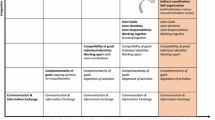Abstract
Product-driven systems (PDS) may enable manufacturing companies to meet business demands more quickly and effectively, by localizing decision as near as possible to the material flows. However, the actual architecture of a PDS is still not well defined. This paper proposes a PDS architecture based on a particular interpretation of the concept of stigmergy, where cooperation between production actors is achieved thanks to attributes (informational pheromones) attached to products. This stigmergic design pattern is presented. Agent-oriented components which implement it are presented, are firstly applied to a laboratory platform, and secondly on an industrial test-case.
Similar content being viewed by others
References
Albus J., Barbera A. (2005) Rcs: A cognitive architecture for intelligent multi-agent systems. Annual Reviews in Control 29(1): 87–99
Babiceanu R., Chen F. (2006) Development and applications of holonic manufacturing systems: A survey. Journal of Intelligent Manufacturing 17(1): 111–131
Bellifemine F., Caire G., Greenwood D. (2007) Developing multi-agent systems with JADE (Wiley series in agent technology). Wiley, Hoboken, New Jersey
Brennan R., Norrie D. (2001) Evaluating the performance of reactive control architectures for manufacturing production control. Computers in Industry 46(3): 235–245
Bussmann, S., & Schild, K. (2001). An agent-based approach to the control of flexible production systems. In: Proceedings of the 8th IEEE international conference on Emergent Technologies and Factory Automation (ETFA 2001), pp. 481–488. Antibes Juan-les-pins, France.
Christopher M. (2000) The agile supply chain: Competing in volatile markets. Industrial Marketing Management 29(1): 37–44
Dorigo M., Gambardella L. (1997) Ant colony system: A cooperative learning approach to the traveling salesman problem. IEEE Transactions on Evolutionary Computation 1(1): 53–66
FIPA. (2005). The foundation for intelligent physical agents. http://www.fipa.org/repository/index.html.
Främling K., Ala-Risku T., Kärkkäinen M., Holmström J. (2007) Design patterns for managing product life cycle information. Communications of the ACM 50: 75–79
Garnier S., Gautrais J., Theraulaz G. (2007) The biological principles of swarm intelligence. Swarm Intelligence 1: 3–31
Grassé P. (1959) La reconstruction du nid et les coordinations inter-individuelles chez bellicositermes natalensis et cubitermes sp. la théorie de la stigmergie: Essai d’interprétation des termites constructeurs. Insectes Sociaux 6: 41–84
Holmstrom, J., & Framling, K. (2006). Product centric integration:exploring the impact of rfid and agent technology on supply chain management. In: Network-centric collaboration and supporting frameworks, volume 224 of IFIP International Federation for Information Processing. Boston: Springer, pp. 565–572. doi:10.1007/978-0-387-38269-2_59.
Kärkkäinen M., Ala-Risku T., Främling K. (2003) The product centric approach: a solution to supply network information management problems?. Computers in Industry 52(2): 147–159
Klein, T., Thomas, A., Morel, G., & El Haouzi, H. (2008). A simulation-based decision support system: The example of a furniture manufacturer. In: 17th IFAC World Congress 17th IFAC World Congress, pp. 562–568. Seoul Corée, République De, 07.
Leitao P., Restivo F. (2006) Adacor: A holonic architecture for agile and adaptive manufacturing control. Computers in Industry 57(2): 121–130
Maturana F., Norrie D. (1996) Multi-agent mediator architecture for distributed manufacturing. Journal of Intelligent Manufacturing 7: 257–270. doi:10.1007/BF00124828
Mcfarlane D., Sarma S., Chirn J. L., Wong C. Y., Ashton K. (2003) Auto id systems and intelligent manufacturing control. Engineering Applications of Artiflcial Intelligence 16(4): 365–376
Meyer G., Främling K., Holmström J. (2009) Intelligent products: A survey. Computers in Industry 60(3): 137–148
Montreuil, B., Brotherton, E., Ouazzani, N., & Nourelfath, M. (2004). Antzon layout metaheuristic: Coupling zone-based layout optimization, ant colony system and domain knowledge. In: Progress in material handling research, pp. 301–331. Material handling industry of America.
Morel G., Valckenaers P., Faure J. -M., Pereira C. E., Dietrich C. (2007) Manufacturing plan control challenges and isssues. Control Engineering Pratice 15(11): 1321–1331
Pannequin R., Morel G., Thomas A. (2009) The performance of product-driven manufacturing control: An emulation-based benchmarking study. Computers in Industry 60(3): 195–203
Smith R. G. (1980) The contract net protocol: High-level communication and control in a distributed problem solver. IEEE Transactions on Computers 29(12): 1104–1113
Stuit M., Meyer G. (2009) Agent interaction modeling based on product-centric data: A formal method to improve enterprise interoperability. In: Aalst W., Mylopoulos J., Sadeh N. M., Shaw M. J., Szyperski C., Fischer K., Müller J. P., Odell J., Berre A. J. (eds) Agent-based technologies and applications for enterprise interoperability vol. 25 of lecture notes in business information processing. Springer, Berlin, Heidelberg, pp 197–219. doi:10.1007/978-3-642-01668-4_11
Theraulaz G., Bonabeau E. (1999) A brief history of stigmergy. Artificial Life 5(2): 97–116
Valckenaers P., Hadeli , Saint Germain B., Verstraete P., Van Brussel H. (2006) Emergent short-term forecasting through ant colony engineering in coordination and control systems. Advanced Engineering Informatics 20(3): 261–278
van Brussel H., Wyns J., Valckenaers P., Bongaerts L., Peeters P. (1998) Reference architecture for holonic manufacturing systems: Prosa. Computers in Industry 37(3): 255–274
Author information
Authors and Affiliations
Corresponding author
Rights and permissions
About this article
Cite this article
Pannequin, R., Thomas, A. Another interpretation of stigmergy for product-driven systems architecture. J Intell Manuf 23, 2587–2599 (2012). https://doi.org/10.1007/s10845-011-0588-3
Received:
Accepted:
Published:
Issue Date:
DOI: https://doi.org/10.1007/s10845-011-0588-3




